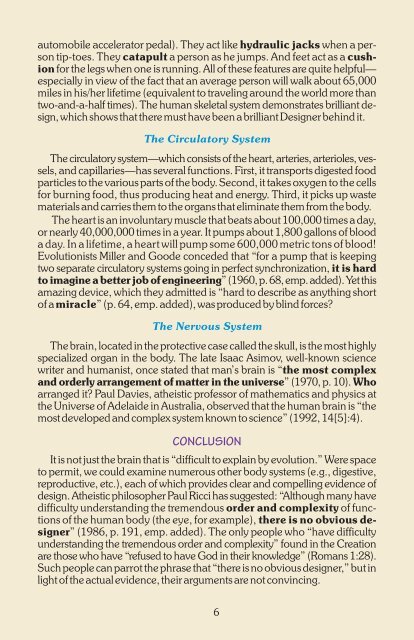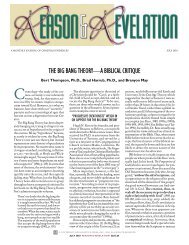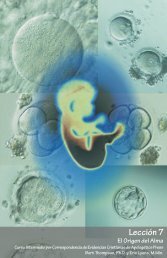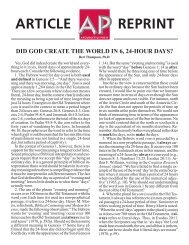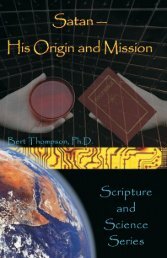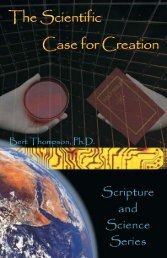Origins: Random Chance or Intelligent Design? - Apologetics Press
Origins: Random Chance or Intelligent Design? - Apologetics Press
Origins: Random Chance or Intelligent Design? - Apologetics Press
- No tags were found...
You also want an ePaper? Increase the reach of your titles
YUMPU automatically turns print PDFs into web optimized ePapers that Google loves.
automobile accelerat<strong>or</strong> pedal). They act like hydraulic jacks when a persontip-toes. They catapult a person as he jumps. And feet act as a cushionf<strong>or</strong> the legs when one is running. All of these features are quite helpful—especially in view of the fact that an average person will walk about 65,000miles in his/her lifetime (equivalent to traveling around the w<strong>or</strong>ld m<strong>or</strong>e thantwo-and-a-half times). The human skeletal system demonstrates brilliant design,which shows that there must have been a brilliant <strong>Design</strong>er behind it.The Circulat<strong>or</strong>y SystemThe circulat<strong>or</strong>y system—which consists of the heart, arteries, arterioles, vessels,and capillaries—has several functions. First, it transp<strong>or</strong>ts digested foodparticles to the various parts of the body. Second, it takes oxygen to the cellsf<strong>or</strong> burning food, thus producing heat and energy. Third, it picks up wastematerials and carries them to the <strong>or</strong>gans that eliminate them from the body.The heart is an involuntary muscle that beats about 100,000 times a day,<strong>or</strong> nearly 40,000,000 times in a year. It pumps about 1,800 gallons of blooda day. In a lifetime, a heart will pump some 600,000 metric tons of blood!Evolutionists Miller and Goode conceded that “f<strong>or</strong> a pump that is keepingtwo separate circulat<strong>or</strong>y systems going in perfect synchronization, it is hardto imagine a better job of engineering” (1960, p. 68, emp. added). Yet thisamazing device, which they admitted is “hard to describe as anything sh<strong>or</strong>tof a miracle” (p. 64, emp. added), was produced by blind f<strong>or</strong>ces?The Nervous SystemThe brain, located in the protective case called the skull, is the most highlyspecialized <strong>or</strong>gan in the body. The late Isaac Asimov, well-known sciencewriter and humanist, once stated that man’s brain is “the most complexand <strong>or</strong>derly arrangement of matter in the universe” (1970, p. 10). Whoarranged it? Paul Davies, atheistic profess<strong>or</strong> of mathematics and physics atthe Universe of Adelaide in Australia, observed that the human brain is “themost developed and complex system known to science” (1992, 14[5]:4).It is not just the brain that is “difficult to explain by evolution.” Were spaceto permit, we could examine numerous other body systems (e.g., digestive,reproductive, etc.), each of which provides clear and compelling evidence ofdesign. Atheistic philosopher Paul Ricci has suggested: “Although many havedifficulty understanding the tremendous <strong>or</strong>der and complexity of functionsof the human body (the eye, f<strong>or</strong> example), there is no obvious designer”(1986, p. 191, emp. added). The only people who “have difficultyunderstanding the tremendous <strong>or</strong>der and complexity” found in the Creationare those who have “refused to have God in their knowledge” (Romans 1:28).Such people can parrot the phrase that “there is no obvious designer,” but inlight of the actual evidence, their arguments are not convincing.6


